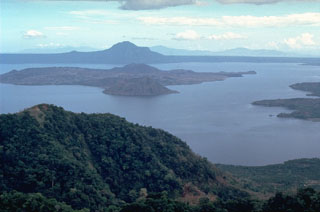Report on Taal (Philippines) — 28 May-3 June 2025
Smithsonian Institution / US Geological Survey
Weekly Volcanic Activity Report, 28 May-3 June 2025
Managing Editor: Sally Sennert.
Please cite this report as:
Global Volcanism Program, 2025. Report on Taal (Philippines) (Sennert, S, ed.). Weekly Volcanic Activity Report, 28 May-3 June 2025. Smithsonian Institution and US Geological Survey.
Taal
Philippines
14.0106°N, 120.9975°E; summit elev. 311 m
All times are local (unless otherwise noted)
The Philippine Institute of Volcanology and Seismology (PHIVOLCS) reported continuing unrest at Taal during 27 May-3 June. There were 0-20 daily volcanic earthquakes and a few periods of tremor that lasted 1-10 minutes long during 27-30 May and on 2 June; no volcanic earthquakes were recorded during 31 May-1 June. Daily gas-and-steam emissions that were sometimes voluminous rose 900-1,500 m above the crater rim and drifted NW and NE. Hot fluids upwelling in the lake were periodically observed. Sulfur dioxide emissions averages were 1,351-6,289 tonnes per day on most days. A minor phreatic eruption lasting four minutes occurred on 29 May. The Alert Level remained at 1 (on a scale of 0-5); PHIVOLCS reminded the public that the entire Taal Volcano Island was a Permanent Danger Zone (PDZ) and recommended that the Main Crater and areas along the Daang Kastila fissure should remain prohibited.
Geological Summary. Taal is one of the most active volcanoes in the Philippines and has produced some powerful eruptions. The 15 x 20 km Talisay (Taal) caldera is largely filled by Lake Taal, whose 267 km2 surface lies only 3 m above sea level. The maximum depth of the lake is 160 m, with several submerged eruptive centers. The 5-km-wide Volcano Island in north-central Lake Taal is the location of all observed eruptions. The island is composed of coalescing small stratovolcanoes, tuff rings, and scoria cones. Powerful pyroclastic flows and surges have caused many fatalities.
Source: Philippine Institute of Volcanology and Seismology (PHIVOLCS)

